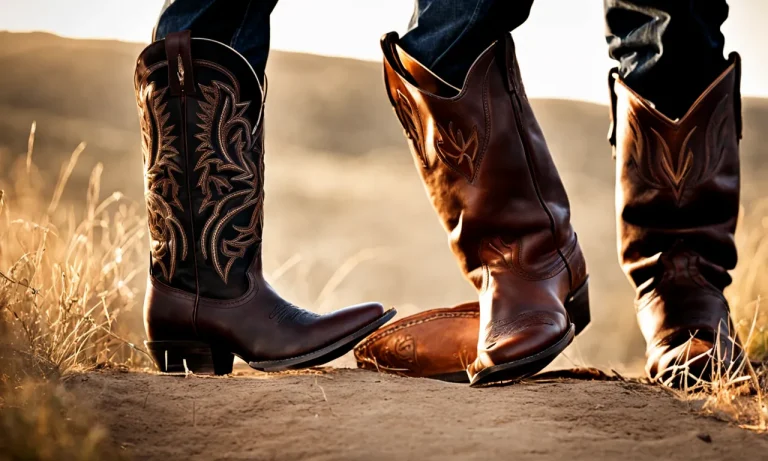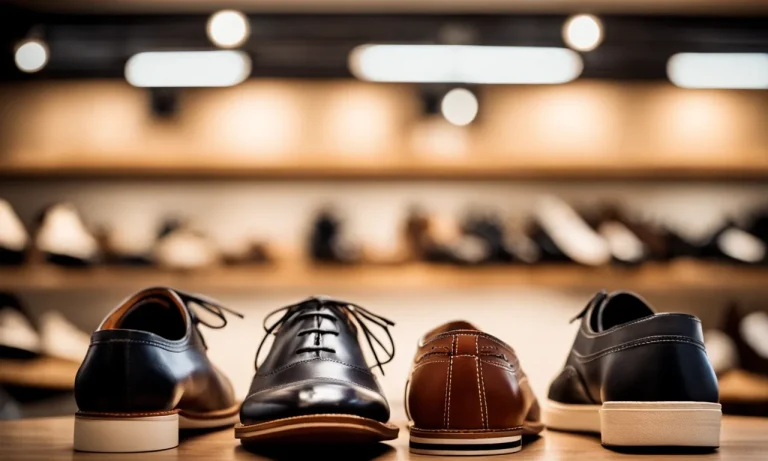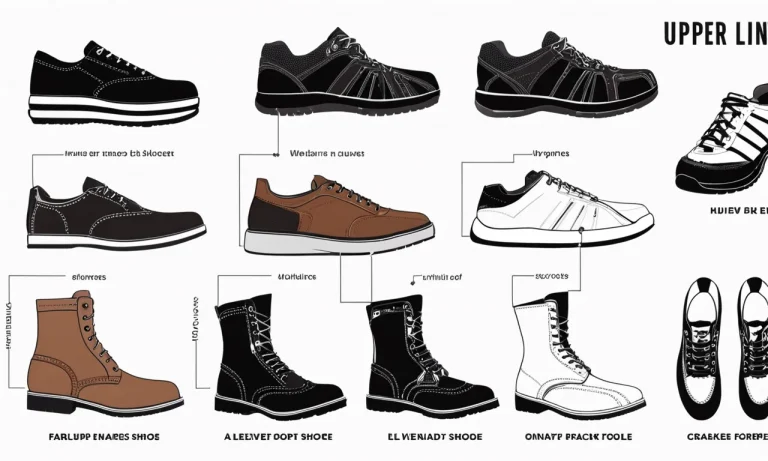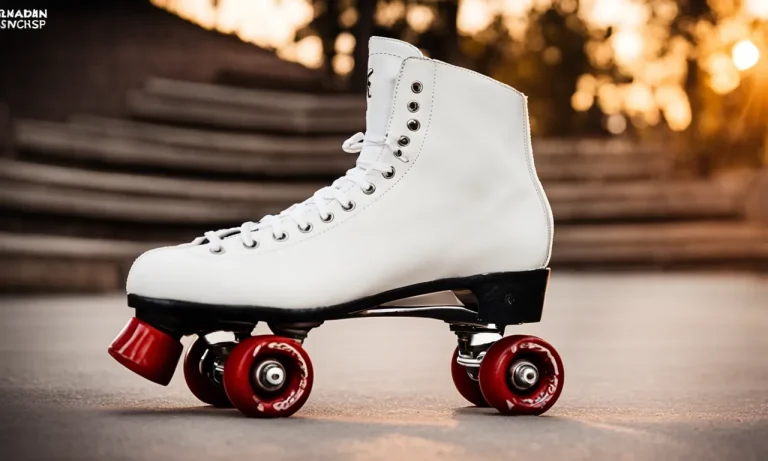Shoes are one of the most important fashion accessories that complete any outfit. While men’s and women’s shoes may look similar, there are some key differences when it comes to style, fit, and comfort.
If you’re short on time, here’s a quick answer to your question: men’s and women’s shoes differ in width sizing, heel height, and design elements based on gender-specific needs. Women’s shoes tend to be narrower, have higher heels, and incorporate more decorative accents than men’s shoes.
In this comprehensive 3000 word guide, we will compare men’s and women’s footwear by exploring the key differences in sizing, common shoe styles, construction and materials, and factors like comfort and performance.
Sizing and Fit
When it comes to sizing and fit, there are several key differences between men’s and women’s shoes. Understanding these differences can help you find the perfect pair that not only looks great but also feels comfortable on your feet.
Women’s Widths are Narrower
One of the main differences in sizing between men’s and women’s shoes is the width. Generally, women’s shoes tend to have narrower widths compared to men’s shoes. This is because women’s feet are typically narrower than men’s feet.
It’s important to take this into consideration when selecting your shoe size. If you have wider feet, you may need to opt for a men’s shoe or look for women’s shoes that are specifically designed for wider feet.
Men’s Sizes Run Larger
Another notable difference is that men’s shoe sizes tend to run larger compared to women’s sizes. For example, if you wear a size 7 in women’s shoes, you may need to go down a size or two when purchasing men’s shoes.
It’s always a good idea to try on shoes and check the size chart to ensure the best fit. Keep in mind that different shoe brands may have slight variations in sizing, so it’s important to measure your feet and refer to the specific brand’s size guide.
Anatomical Differences in Feet
The differences in sizing and fit also stem from the anatomical differences between men’s and women’s feet. Men tend to have wider heels and a higher arch, while women generally have narrower heels and a lower arch. These differences can affect the overall fit and comfort of the shoe.
It’s crucial to find shoes that provide proper support and accommodate these anatomical differences to prevent discomfort and potential foot problems.
For more information on foot anatomy and finding the right shoe size, you can visit websites such as American Podiatric Medical Association (APMA) or Podiatrist Lancaster.
Common Shoe Styles
Heels
Heels are a popular shoe style for both men and women, but they are typically associated more with women’s fashion. Women’s heels come in a wide variety of heights and styles, ranging from stilettos to kitten heels. They are often worn for formal occasions or to add a touch of elegance to an outfit.
Men’s heels, on the other hand, are less common and tend to be found in certain subcultures or fashion-forward circles. Examples include Cuban heels, which are popular in men’s boots, and elevator shoes, which have built-in height increasing features.
Flats
Flats are comfortable and versatile shoe styles that are popular among both men and women. Women’s flats often come in ballet shoe designs or loafers, while men’s flats are commonly seen in the form of loafers or boat shoes.
These shoes are suitable for casual or semi-formal occasions and can be paired with a variety of outfits. They are a great option for those who prefer a more relaxed and laid-back style.
Boots
Boots are a staple in both men’s and women’s footwear collections. However, there are some differences in the styles and designs. Women’s boots often come in a wider range of options, such as ankle boots, knee-high boots, and over-the-knee boots.
They also tend to have more decorative elements like buckles, studs, or embroidery. Men’s boots, on the other hand, are typically more rugged and utilitarian, with styles like work boots, combat boots, and Chelsea boots being popular choices.
Sneakers
Sneakers are a go-to shoe style for both men and women. They are comfortable, versatile, and can be worn for various occasions. While there are many unisex sneaker options available, there are also specific designs tailored to each gender.
Women’s sneakers often have more vibrant colors, patterns, and embellishments, while men’s sneakers tend to have a more minimalist and sporty look. Both men and women can enjoy a wide variety of brands, such as Nike, Adidas, Puma, and New Balance.
Loafers
Loafers are a classic shoe style that can be found in both men’s and women’s footwear collections. Women’s loafers often have a more feminine and sleek design, with options like tassel loafers or penny loafers. Men’s loafers, on the other hand, are known for their timeless and sophisticated look.
They are often made from high-quality materials like leather and are a popular choice for formal or business settings.
Sandals
Sandals are a popular shoe style, especially during the warmer months. Both men and women can find a wide variety of sandal options to suit their style and needs. Women’s sandals often feature more intricate designs, such as gladiator sandals, wedge sandals, or flip-flops with embellishments.
Men’s sandals, on the other hand, are typically more minimalistic, with options like slide sandals or flip-flops. Sandals are great for casual occasions or when you want to keep your feet cool and comfortable.
Construction and Materials
When it comes to the construction and materials used in men’s and women’s shoes, there are several key differences to consider. These variations can affect not only the overall design and style of the shoes but also their comfort and durability.
Soles
The soles of men’s and women’s shoes are often designed differently to accommodate the differences in foot shape and walking patterns. Men’s shoes typically have wider and thicker soles to provide better stability and support, especially in the heel area.
On the other hand, women’s shoes tend to have narrower and thinner soles to match the narrower shape of their feet. This design difference aims to enhance flexibility and allow for a more natural stride.
Additionally, the materials used for the soles can also vary. While both men’s and women’s shoes commonly feature rubber soles for traction and durability, men’s shoes may incorporate more rugged materials like leather or durable synthetic compounds for added longevity.
Uppers
The uppers of men’s and women’s shoes also differ in terms of design and materials. Men’s shoes often have a broader and more straightforward construction, prioritizing functionality and durability. They are typically made with materials like leather or synthetic fabrics that offer better protection and support.
On the other hand, women’s shoes often prioritize style and aesthetics. The uppers of women’s shoes may feature more intricate designs, patterns, and embellishments to cater to different fashion preferences.
They are commonly made with lighter materials like canvas, mesh, or suede, which provide a more breathable and flexible fit.
Linings and Padding
The linings and padding inside men’s and women’s shoes also differ to accommodate the unique needs of each gender. Men’s shoes tend to have thicker and more cushioned linings and padding to provide extra support and comfort during long hours of wear.
This is especially important for men who often engage in activities that require more physical exertion.
Women’s shoes, on the other hand, typically have lighter and less bulky linings and padding to maintain a sleeker and more feminine profile. However, manufacturers still strive to ensure that women’s shoes offer adequate comfort and support by using materials that conform to the foot’s natural shape and provide targeted cushioning in key areas.
Understanding the construction and materials used in men’s and women’s shoes can help you make informed choices when selecting the right pair for your needs. Whether you prioritize functionality, style, or a combination of both, it’s important to consider these differences to ensure a comfortable and enjoyable wearing experience.
Comfort and Performance
When it comes to choosing the right shoes, comfort and performance are two crucial factors that both men and women consider. Let’s take a closer look at how men’s and women’s shoes compare in terms of cushioning and support, breathability, traction, and grip.
Cushioning and Support
Both men’s and women’s shoes are designed to provide cushioning and support, but there are some differences in the way they are constructed. Men’s shoes tend to have a wider heel and more cushioning in the midsole to accommodate their larger body frames.
On the other hand, women’s shoes often have a narrower heel and additional arch support to cater to the unique shape of women’s feet.
According to a study conducted by the American Orthopaedic Foot & Ankle Society, women generally have a higher arch and a wider forefoot compared to men. This anatomical difference means that women may require more cushioning and support in specific areas of their shoes.
Therefore, it is important for women to choose shoes that are specifically designed to meet their unique needs.
Breathability
Both men’s and women’s shoes now feature advanced materials and technologies to enhance breathability and keep feet cool and dry. However, there may be slight variations in the design and placement of ventilation features.
For example, men’s shoes may have larger mesh panels or perforations on the upper to allow for better airflow. Women’s shoes, on the other hand, may have smaller ventilation areas strategically placed to address their specific foot shape and needs.
Traction and Grip
When it comes to traction and grip, both men’s and women’s shoes are designed to provide excellent stability on different surfaces. The outsoles of these shoes often feature varying patterns and materials to enhance grip and prevent slipping.
However, there may be differences in the way the traction is distributed.
Men’s shoes tend to have a wider and more aggressive tread pattern to provide better traction on rough terrains. Women’s shoes, on the other hand, may have a more balanced tread pattern to offer stability and grip without compromising flexibility.
It’s important to note that these differences are generalizations, and there are many unisex shoe options available that cater to both men’s and women’s needs. Ultimately, the most important factor in choosing the right shoe is finding one that fits well and offers the necessary comfort and support for your individual feet.
Conclusion
While men’s and women’s shoes may appear similar at first glance, they are designed, constructed, and sized differently to accommodate anatomical variations as well as stylistic preferences. Factors like heel height, materials, and decorative details in women’s shoes cater to fashion sensibilities, while men’s shoes focus more on function and rugged durability.
Understanding key differences like sizing, silhouettes, and technical elements can help you find the perfect pair of shoes tailored specifically for your needs and preferences, whether you are a man or woman.






